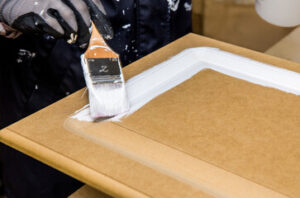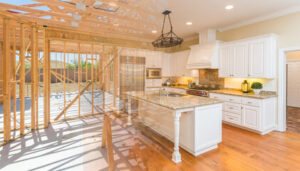Cabinet Painting – Give Your Cabinets a Fresh Look
Cabinet Painting Sacramento is a cost-effective and design versatile option for giving a new look to your kitchen cabinets. You can easily achieve a dramatic transformation in a shorter timeframe than other remodel options.

Paint that is too similar to your wall color can cause the different surfaces to fight for the same color/depth slot and result in a hot mess. Make sure that your colors are more than 20 LRV points apart.
Cabinet Painting is a way to give your kitchen or bathroom a dramatic facelift at a much lower cost than refacing or replacing cabinets. While it may seem like a straightforward weekend project, proper surface preparation is key to ensure long-lasting results and durability.
One of the most important parts of this process is sanding. While many people skip this step, sanding is vital for any successful painting job. Without sanding, the paint will struggle to adhere to the cabinet surface and may eventually peel or bubble. Additionally, sanding smooths the finish for easy handling and a clean look.
Another crucial step is priming. Unlike wall paints, cabinet paints require primer to provide a good surface for the finish. Primer also helps to conceal any stains or discoloration that may exist on the surface of your cabinetry. Lastly, primer helps to seal the surface and prevent bleed from bleeding through your finished coat of paint.
Once the sanding and priming is complete, it’s time to start painting! Start by using a brush to get inside the cabinet doors and drawers and then use a foam roller for any exposed or easier-to-reach areas. Be sure to allow at least 2 hours for the primer to dry before moving the cabinets back into place.
Before you begin, be sure to remove any decorative hardware from your cabinets and place all screws, hinges, or other small pieces in a safe location so you don’t lose them. Next, thoroughly clean the cabinets with a degreaser to cut through any grease and dirt buildup. Once the cabinets are completely cleaned, be sure to tape off any walls, appliances, hood vents, or anything else you don’t want to get paint on.
Primer
While it may seem like an extra step, priming is the foundation of a quality paint job. It creates a strong base that withstands moisture and protects the surface, whether it’s wood or metal. Without it, cabinets often chip, crack and peel. It also helps the paint hold onto its color.
In order to ensure a smooth finish, all surfaces need to be primed before painting. This is especially important in kitchens, where cabinets take a beating from constant opening and closing, steam, and moisture. Cabinet primers like BIN Shellac Primer form a bond between the surface and the paint, helping it to adhere.
After the primer dries, it’s time to sand. Lightly sanding the cabinets improves paint adhesion and removes any sheen. Using an electric sander makes the process much easier and faster.
Once the sanding is done, wipe down the cabinets again to remove dust and residue. Then apply a second coat of BIN Shellac Primer to ensure a smooth and even finish.
Depending on the type of paint you are using, you may also need to apply a basecoat or stain blocking primer. These are especially important if you’re changing the color of your cabinets, as they will help the new paint cover any stains and prevent them from bleeding through.
Whether you are doing a subtle refresh or a dramatic color change, a good cabinet primer and quality paint will help your project look professional and last longer. Don’t skip this crucial step – it will save you time and money in the long run!
Repair
Before you start sanding, it’s important to carefully inspect your cabinets for any damage or areas that need repair. Any cracks or holes should be filled with wood filler and allowed to dry before sanding again. A hammer and screwdriver set are handy tools to have on hand for making small adjustments and tightening loose hinges or knobs. A power drill is useful for more extensive repairs and a putty knife will be needed to apply wood filler to deeper cracks or gouges.
If your cabinet frames have previous paint on them, it’s essential to strip them before you can paint. Stripping is a messy process and it’s important to work in a well-ventilated area. Be sure to follow all the manufacturer’s instructions for using the stripper. If you skip this step, your new coat of paint will be compromised and may flake or peel later on.
After stripping and sanding, the cabinet frames should be primed. A high-quality oil or latex primer is essential to ensure that your new coat of paint will adhere properly and last longer. Once the primer is dry, it’s important to sand and clean the surfaces again with a rag or tack cloth before applying the final coat of paint.
It’s important to take the time to apply your paint evenly and smoothly, especially on the corners and edges of the cabinet boxes. Depending on the color you’re painting over, it may take up to three coats of paint for full coverage and a smooth finish. It’s also important to allow each coat of paint adequate time to dry between applications. This is usually a few days or more, depending on the type of paint and environmental conditions.
Sanding
Often overlooked, sanding is an essential step in the cabinet painting process. It helps to level out any bumps, dents, or rough surfaces and creates a smooth canvas that paint can glide onto easily and evenly, resulting in a more professional and refined appearance. Skipping this step can have negative consequences, including paint that isn’t adhered properly and a finish that looks uneven or discolored.
When sanding cabinets, it’s important to use the right grits of sandpaper. Starting too coarsely can damage the wood or leave gouges in it, while using too fine a grit will remove too much and not provide an even surface. To get the best results, always work with a sanding block or an orbital sander that can be adjusted to your needs.
It’s also important to wear a mask when sanding to avoid inhaling any dust or paint particles. For larger projects, a sanding vacuum can help to keep the area clean and free of debris while you’re working. Finally, it’s a good idea to label where all the hardware goes so you can reinstall it properly when the project is finished.
In some cases, it may be necessary to apply a deglosser or chemical stripper to the cabinets before sanding. These products can help remove any gloss and roughen the surface without the need for sanding, but they aren’t without their risks. Be sure to read the manufacturer’s instructions carefully and follow any safety precautions closely. A deglosser can also leave behind a sticky residue that will make it difficult to clean and can cause the new paint or stain to bubble. If you decide to use a deglosser, it’s essential to prep the cabinets for a fresh coat of primer as well.
Paint
Cabinet painting requires thorough surface prep, including sanding and priming to ensure adhesion and a smooth finish. It is also time-consuming and labor-intensive. In addition, it doesn’t address underlying structural or functional issues. If your cabinets are in need of significant repair, refacing may be a better option.
The type of paint you use is also important. There are special cabinet paints that offer durability and stain resistance, especially for high-traffic areas like kitchens. They are typically acrylic latex-based and can be a semi-gloss or satin finish. Glossy finishes can show imperfections and are more difficult to clean, so satin is a better choice.
If you decide to spray your cabinets, be sure to purchase a high-quality spray paint. This type of paint produces a smooth, durable finish and can cover more surface area in less time than brushing or rolling. It also uses less paint, which can save you money in the long run. Spray paint is also easier to use and generates less mess compared to brushing or rollers. It’s also easier to access hard-to-reach areas, such as crevices and corners, when spraying.
Before you start painting, be sure to remove all the hardware from your cabinets and put it in a bag or box. Label the bags or boxes to indicate where each piece goes when it is reinstalled. It’s also a good idea to protect the floor and countertops with plastic wrap or sheets. Lastly, be sure to cover and seal your tools and brushes between coats to prevent dust or splatter from getting on them. Allow your painted cabinets to dry for at least a few hours before you reinstall them.
